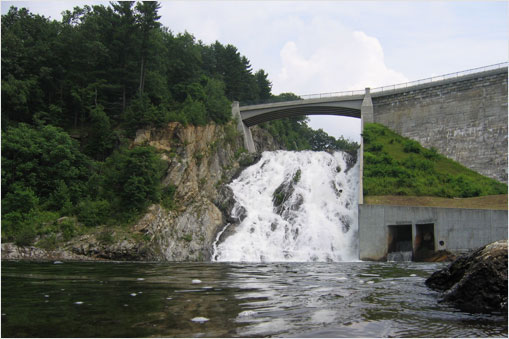 May 24, 2013 CONTACT: Adam Bosch (DEP) (845) 334-7868 / Chris Gilbride (718) 595-6600 Department of Environmental Protection Announces Reopening of Walkway Atop Cross River Dam for RecreationPath atop Dam Will Be Open for Walking, Biking and Other Outdoor Recreation for the First Time Since 1996The New York City Department of Environmental Protection (DEP) today announced that it has reopened the path atop the Cross River Dam for walking, running, and bicycling for the first time since 1996. The dirt path, located between Reservoir Road and Mount Holly Road in the Town of Bedford, is roughly one-quarter mile long, and connects other dirt roads comprising 8 to 10 miles of trails that are often used by local residents and visitors for outdoor recreation. “Reopening the roadway on the Cross River Dam is another example of DEP’s efforts to provide the communities that supply the metropolitan area with some of the highest quality drinking water in the country access to public spaces that support recreation and tourism,” said DEP Commissioner Carter Strickland. “Over the past several years, we have worked with our neighbors to open thousands of acres of lands and waters for activities that keep our drinking water safe and allow residents and visitors alike to enjoy the beauty of New York City’s reservoirs.” “I appreciate Mayor Bloomberg and Commissioner Strickland working with us to reopen for pedestrians the Cross River Dam and Kensico Dam,” said Westchester County Executive Robert P. Astorino. “The City continues to be a good neighbor and has found the right balance between proper security and open access for these important environmental and recreational areas.” The reopening marks the first time the path will be open since 1996, when it was closed for a rehabilitation project that installed a new fountain, enhanced the spillway, and rehabilitated the reservoir gatehouse. That project was just being completed when the attacks of Sept. 11, 2001 happened, forcing the closure of such sites for security reasons. In recent years, several similar sites have been reopened for recreation, including the roadway above Kensico Reservoir. Signs at each end of the pathway will explain certain guidelines for its use. For example: the path will be open from dawn to dusk, leashed dogs are allowed, but owners are required to clean up after their dogs, horses and motorized vehicles are prohibited, and people using the trail are not permitted to climb or sit on the edges of the dam. Winter maintenance will also be limited. Since 2003, DEP has significantly expanded the amount of City properties within the watersheds that are open for recreation. There are now 114,833 acres open for recreation, including 80,941 acres of land and 33,892 acres of reservoirs. Of that, 52,198 acres of land are in public access areas that are open to recreation without a DEP permit, including the pathway at the Cross River Dam. Expanding recreational opportunities in the watershed is one of the goals outlined in Strategy 2011-2014, a comprehensive strategic plan that outlines 100 distinct initiatives to help ensure DEP is the safest, most efficient, cost-effective, and transparent water utility in the nation. For more information about recreational opportunities on New York City lands and waters, download or view DEP’s 2013 Watershed Recreation Newsletter. A copy has also been posted on the Department’s Facebook page at www.facebook.com/nycwater. DEP manages New York City’s water supply, providing more than one billion gallons of water each day to more than 9 million residents, including 8.3 million in New York City, and residents of Ulster, Orange, Putnam, and Westchester counties. This water comes from the Catskill, Delaware, and Croton watersheds that extend more than 125 miles from the City, and the system comprises 19 reservoirs, three controlled lakes, and numerous tunnels and aqueducts. DEP employs nearly 6,000 employees, including almost 1,000 scientists, engineers, surveyors, watershed maintainers and others professionals in the upstate watershed. In addition to its $68 million payroll and $157 million in annual taxes paid in upstate counties, DEP has invested more than $1.5 billion in watershed protection programs—including partnership organizations such as the Catskill Watershed Corporation and the Watershed Agricultural Council—that support sustainable farming practices, environmentally sensitive economic development, and local economic opportunity. In addition, DEP has a robust capital program with over $14 billion in investments planned over the next 10 years that will create up to 3,000 construction-related jobs per year. For more information, visit www.nyc.gov/dep, like us on Facebook at www.facebook.com/nycwater, or follow us on Twitter at www.twitter.com/nycwater. | ||